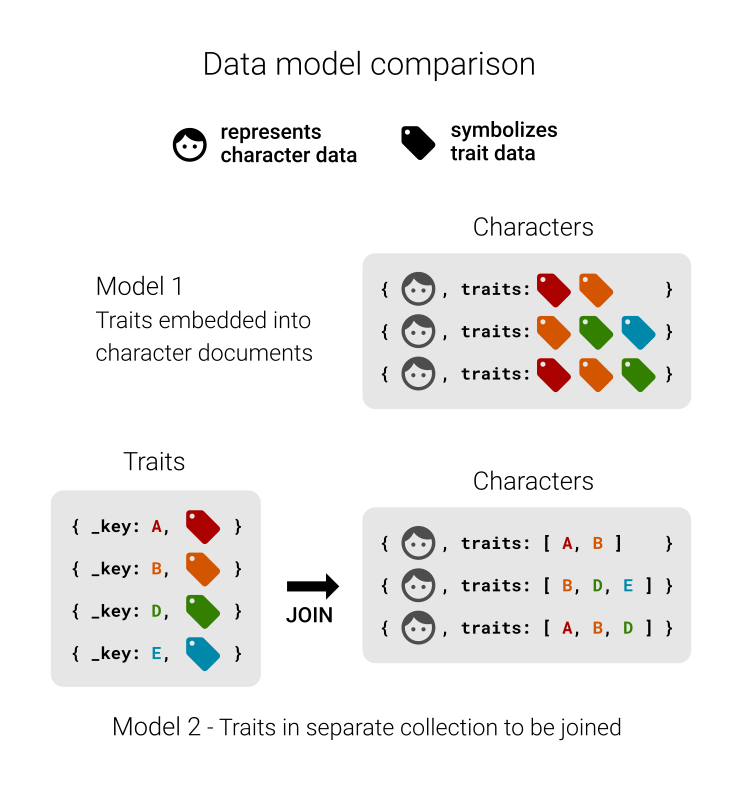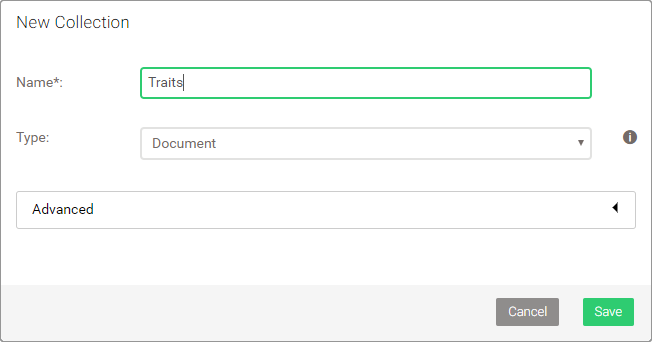ArangoDB v3.4 reached End of Life (EOL) and is no longer supported.
This documentation is outdated. Please see the most recent version here: Latest Docs
Joining together
References to other documents
The character data we imported has an attribute traits for each character, which is an array of strings. It does not store character features directly however:
{
"name": "Ned",
"surname": "Stark",
"alive": false,
"age": 41,
"traits": ["A","H","C","N","P"]
}
It is rather a list of letters without an apparent meaning. The idea here is that traits is supposed to store documents keys of another collection, which we can use to resolve the letters to labels such as “strong”. The benefit of using another collection for the actual traits is, that we can easily query for all existing traits later on and store labels in multiple languages for instance in a central place. If we would embed traits directly…
{
"name": "Ned",
"surname": "Stark",
"alive": false,
"age": 41,
"traits": [
{
"de": "stark",
"en": "strong"
},
{
"de": "einflussreich",
"en": "powerful"
},
{
"de": "loyal",
"en": "loyal"
},
{
"de": "rational",
"en": "rational"
},
{
"de": "mutig",
"en": "brave"
}
]
}
… it becomes really hard to maintain traits. If you were to rename or translate one of them, you would need to find all other character documents with the same trait and perform the changes there too. If we only refer to a trait in another collection, it is as easy as updating a single document.

Importing traits
Below you find the traits data. Follow the pattern shown in Create documents to import it:
- Create a document collection Traits
- Assign the data to a variable in AQL,
LET data = [ ... ] - Use a
FORloop to iterate over each array element of the data INSERTthe elementINTO Traits

[
{ "_key": "A", "en": "strong", "de": "stark" },
{ "_key": "B", "en": "polite", "de": "freundlich" },
{ "_key": "C", "en": "loyal", "de": "loyal" },
{ "_key": "D", "en": "beautiful", "de": "schön" },
{ "_key": "E", "en": "sneaky", "de": "hinterlistig" },
{ "_key": "F", "en": "experienced", "de": "erfahren" },
{ "_key": "G", "en": "corrupt", "de": "korrupt" },
{ "_key": "H", "en": "powerful", "de": "einflussreich" },
{ "_key": "I", "en": "naive", "de": "naiv" },
{ "_key": "J", "en": "unmarried", "de": "unverheiratet" },
{ "_key": "K", "en": "skillful", "de": "geschickt" },
{ "_key": "L", "en": "young", "de": "jung" },
{ "_key": "M", "en": "smart", "de": "klug" },
{ "_key": "N", "en": "rational", "de": "rational" },
{ "_key": "O", "en": "ruthless", "de": "skrupellos" },
{ "_key": "P", "en": "brave", "de": "mutig" },
{ "_key": "Q", "en": "mighty", "de": "mächtig" },
{ "_key": "R", "en": "weak", "de": "schwach" }
]
Resolving traits
Let’s start simple by returning only the traits attribute of each character:
FOR c IN Characters
RETURN c.traits
[
{ "traits": ["A","H","C","N","P"] },
{ "traits": ["D","H","C"] },
...
]
Also see the Fundamentals of Objects / Documents about attribute access.
We can use the traits array together with the DOCUMENT() function to use
the elements as document keys and look them up in the Traits collection:
FOR c IN Characters
RETURN DOCUMENT("Traits", c.traits)
[
[
{
"_key": "A",
"_id": "Traits/A",
"_rev": "_V5oRUS2---",
"en": "strong",
"de": "stark"
},
{
"_key": "H",
"_id": "Traits/H",
"_rev": "_V5oRUS6--E",
"en": "powerful",
"de": "einflussreich"
},
{
"_key": "C",
"_id": "Traits/C",
"_rev": "_V5oRUS6--_",
"en": "loyal",
"de": "loyal"
},
{
"_key": "N",
"_id": "Traits/N",
"_rev": "_V5oRUT---D",
"en": "rational",
"de": "rational"
},
{
"_key": "P",
"_id": "Traits/P",
"_rev": "_V5oRUTC---",
"en": "brave",
"de": "mutig"
}
],
[
{
"_key": "D",
"_id": "Traits/D",
"_rev": "_V5oRUS6--A",
"en": "beautiful",
"de": "schön"
},
{
"_key": "H",
"_id": "Traits/H",
"_rev": "_V5oRUS6--E",
"en": "powerful",
"de": "einflussreich"
},
{
"_key": "C",
"_id": "Traits/C",
"_rev": "_V5oRUS6--_",
"en": "loyal",
"de": "loyal"
}
],
...
]
The DOCUMENT() function can be used
to look up a single or multiple documents via document identifiers. In our
example, we pass the collection name from which we want to fetch documents
as first argument ("Traits") and an array of document keys (_key attribute)
as second argument. In return we get an array of the full trait documents
for each character.
This is a bit too much information, so let’s only return English labels using the array expansion notation:
FOR c IN Characters
RETURN DOCUMENT("Traits", c.traits)[*].en
[
[
"strong",
"powerful",
"loyal",
"rational",
"brave"
],
[
"beautiful",
"powerful",
"loyal"
],
...
]
Merging characters and traits
Great, we resolved the letters to meaningful traits! But we also need to know to which character they belong. Thus, we need to merge both the character document and the data from the trait documents:
FOR c IN Characters
RETURN MERGE(c, { traits: DOCUMENT("Traits", c.traits)[*].en } )
[
{
"_id": "Characters/2861650",
"_key": "2861650",
"_rev": "_V1bzsXa---",
"age": 41,
"alive": false,
"name": "Ned",
"surname": "Stark",
"traits": [
"strong",
"powerful",
"loyal",
"rational",
"brave"
]
},
{
"_id": "Characters/2861653",
"_key": "2861653",
"_rev": "_V1bzsXa--B",
"age": 40,
"alive": false,
"name": "Catelyn",
"surname": "Stark",
"traits": [
"beautiful",
"powerful",
"loyal"
]
},
...
]
The MERGE() functions merges objects together. Because we used an object
{ traits: ... } which has the same attribute name traits as the original
character attribute, the latter got overwritten by the merge operation.
Join another way
The DOCUMENT() function utilizes primary indices to look up documents quickly.
It is limited to find documents via their identifiers however. For a use case
like in our example it is sufficient to accomplish a simple join.
There is another, more flexible syntax for joins: nested FOR loops over
multiple collections, with a FILTER condition to match up attributes.
In case of the traits key array, there needs to be a third loop to iterate
over the keys:
FOR c IN Characters
RETURN MERGE(c, {
traits: (
FOR key IN c.traits
FOR t IN Traits
FILTER t._key == key
RETURN t.en
)
})
For each character, it loops over its traits attribute (e.g. ["D","H","C"])
and for each document reference in this array, it loops over the Traits
collections. There is a condition to match the document key with the key
reference. The inner FOR loop and the FILTER get transformed to a primary
index lookup in this case instead of building up a Cartesian product only to
filter away everything but a single match: Document keys within a collection
are unique, thus there can only be one match.
Each written-out, English trait is returned and all the traits are then merged
with the character document. The result is identical to the query using
DOCUMENT(). However, this approach with a nested FOR loop and a FILTER
is not limited to primary keys. You can do this with any other attribute as well.
For an efficient lookup, make sure you add a hash index for this attribute.
If its values are unique, then also set the index option to unique.

